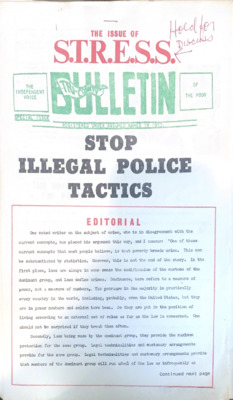S.T.R.E.S.S. - Civil Rights Versus Public Safety
Compelling Question: How does society balance civil rights and public safety through the lens of 1970s Detroit?
Supporting Questions:
What factors led to the formation of STRESS in 1970s Detroit?
How did the formation of STRESS impact race relations in the City of Detroit?
What strategies did individuals and the community utilize to end the STRESS program?
Michigan Grade Level Content Expectations
6.1.3 Urbanization – explain the causes and consequences of urbanization, including: • the location and expansion of major urban centers and their link to industry and trade. • internal migration, including the Great Migration. • the development of cities divided by race, ethnicity, and class, as well as the resulting tensions among and within groups.
6.1.4 Growth and Change – explain the social, political, economic, and cultural shifts taking place in the United States at the end of the 19th century and beginning of the 20th century, by: evaluating the treatment of African Americans, including the rise of segregation in the South as endorsed by the Supreme Court’s decision in Plessy v. Ferguson, and describing the response of African-Americans to this inequality.
6.3.2 Analyze the social, political, economic, and cultural changes that occurred during the Progressive Era.
8.3 Civil Rights in the Post-World War II Era.
8.3.1 Civil Rights Movement – analyze key events, ideals, documents, and organizations in the struggle for African-American civil rights.
8.3.5 Tensions and Reactions to Poverty and Civil Rights – analyze the causes and consequences of the civil unrest that occurred in American cities, by comparing civil unrest in Detroit with at least one other American city.
C – 2.1.2 Identify and analyze various Democratic Values of the United States as found in the Declaration of Independence.
C3.3 Additional Actors and Influences in American Civic Society.
C – 3.3.1 Describe and analyze how groups and individuals influence public policy.
C4.2 Extensions of Civil Rights and Civil Liberties.
C – 4.2.2 Explain how significant historical events, including but not limited to the suffrage movements and the civil rights movements, resulted in changes to the interpretation of and Amendments to the U.S. Constitution.
C4.3 Examining Tensions and Limits on Rights and Liberties
C – 4.3.2 Describe considerations, criteria, and examples that have been used to deny, limit, or extend protection of individual rights.
C6.2 Rights and Responsibilities in Civic Society
C – 6.2.1 Using examples, explain the rights and responsibilities of U.S. citizens as well all people living in the United States.
C – 6.3.1 Explain the personal dispositions that contribute to knowledgeable and engaged participation in civic communities.
C6.4 Civic Inquiry, Public Policy, Civic Action, and Public Discourse C – 6.4.1 Explain and evaluate how people, individually or collectively, seek to bring the United States closer to its Democratic Values
CCSS Literacy Writing Standards for History/Social Studies
W.S.4 Produce clear and coherent writing
W.S.5 Develop and strengthen writing
W.S.8 Gather relevant information
W.S.9 Draw evidence from texts
